Last week we attended the Future Cities symposium at Manchester School of Architecture which was talking about how the future smart cities are going to look and what is being done about this right now. Fascinating event and great to see how local councils are already starting to think through how technology is going to transform the world we live in. Over the next 5-10 years, I predict that the world we live in will be unrecognisable. The amount of development into smart cities, superfast internet and the internet of things is going to significantly change how the general public interact with the physical world around them.
The speakers at the event ranged from architects, directors of technology strategy boards and futurists. Below we will talk through the key topics that were brought up throughout the day and what this means for businesses and councils in the future.

Rory Hyde

Rory Hyde
The first speaker of the day was Rory Hyde, the curator of Contemporary Architecture and Urbanism at the V&A in London along with the author of the book Future Practice.
Rory opened the talks by saying that architects suffer from a “crisis of relevance” which he said wasn’t just about creating buildings but instead about being relevant for the space where the building lives and for the users of the building. He talked about 4 retreats from solid relevance including;
1) Avant-garde: Which is to try new and experimental ideas within architecture
2) Commerce: Currently developers often set the agenda, not the architects which often leads to extravagant developments that you can see throughout Dubai
3) Icons: Where architects often seek to chase new and exciting shapes of buildings to truly stand out from the crowd. Take for example the Burj Khalifa in Dubai, The Gherkin in London and Sydney Opera House
4) Urban interventions: Looking at personal utopias with clearly fenced off areas from the outside world
Looking into the future, Rory talked through ideas around schools and the availability of rooms and facilities. Imagine an ‘Airbnb for schools’, whereby everyone could get automatically updated with what is happening, information sent directly to their smartphones. If you haven’t heard of Airbnb yet, then it is the hotel booking website that is seriously disrupting the travel industry. The online service allows people to rent out their homes or spare bedrooms through the service. Launching only 6 years ago in 2008, they already have over 550,000 listings in 192 countries and will soon have more availability than the Hilton Worldwide and InterContinental Hotels Group globally. Imagine a system that knew when meeting rooms in a city were free and available for people, that knew when the buses were due so you could be directed to the most relevant place for you.
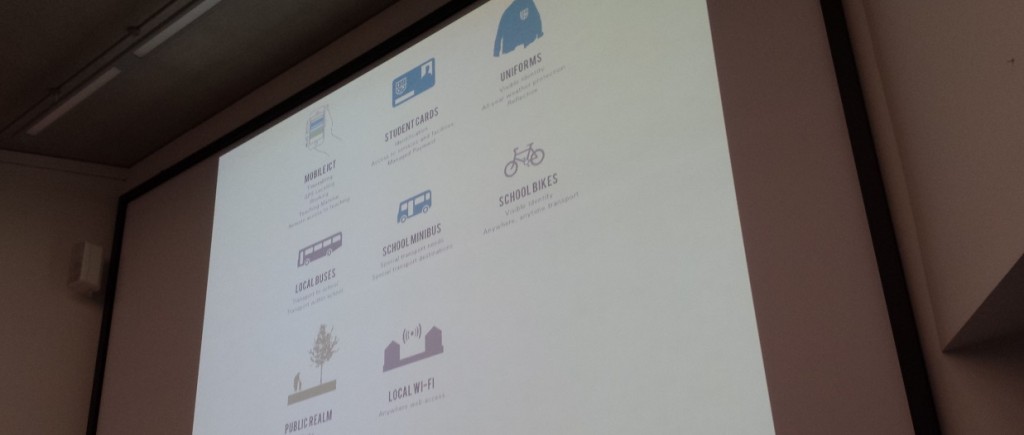
Smart Schools
An interesting point Rory made was around the idea of community architecture such as wind turbines. Often these are installed by large corporations which provide no benefit to the local communities. Which is often one of the reasons why there is so much negativity towards new installations. Instead, imagine a situations whereby local communities directly benefitted from new installations which provided revenue to support local services. This would significantly change the perception of these technologies and would benefit local communities far more.
Following on from this, talk was around a future city that blended with nature. The example given was from Studio Gang’s Bubbly Creek which would allow nature and city to merge together into a natural symbiotic system;
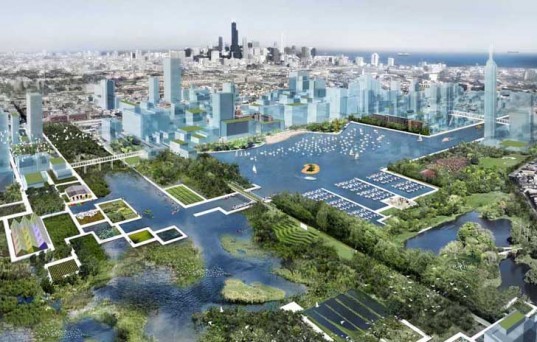
Image source: http://www.wbez.org/blog/alison-cuddy/2012-03-21/can-cultural-resources-help-spur-different-future-chicago-river-97515
While this is an interesting concept, personally I’m not too sure this would work to the extent described in the plans. What is interesting though how future cities are significantly changing as traditional industries are often dwindling in size and scale. Less space is taken up as production increases which is leading to a hollowing out of the traditional urban core.
Tom Cheesewright

Tom Cheesewright
The next speaker of the day was Tom Cheesewright talking about how the future smart city will blend seamlessly with digital technologies. Tom is an Applied Futurist at Book of the Future.
Tom started his talk off by asking the question that if the current technology is affordable and accessible, along with data being cheap then why are smart cities and home automation such a challenge to crack? It comes down to user experience, he stated that “user experience is the last hurdle to for truly smarter cities”.
Smart cities today are essentially technology applied to the build environment to reduce the expenditure and increase efficiencies. This isn’t difficult, it just requires a significantly different approach to thinking about how the systems within the city are used and accessed by the users.
To prove the point, Tom has started to turn his house into a Smart Home with the use of cheap technologies such as the Arduino and Raspberry Pi. Basic implementation initially with automatically turning the lights on and off when entering or leaving a room. The point being that this technology is available now. The future smart city is possible now, when this technology is used throughout.
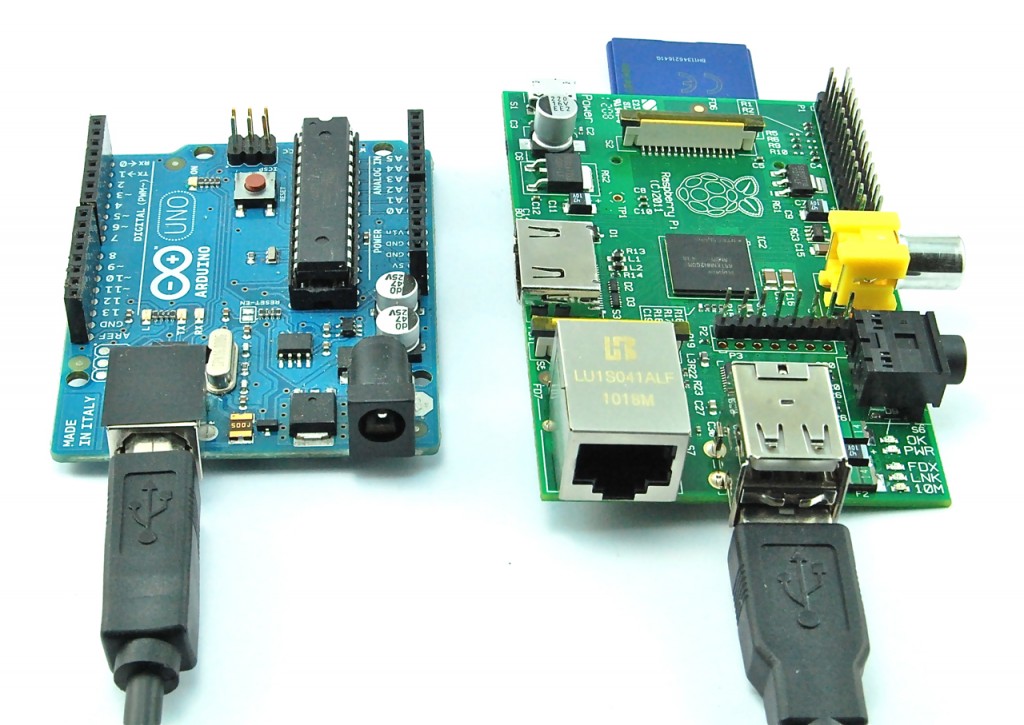
Arduino and Raspberry Pi
Taking this to a whole new level, the Santander Smart City in Spain. The project in Santander is a world first city-scale experimental research system for future smart cities. The project is designed to stimulate the development of future applications for users within the city. As part of the project, over 20,000 sensors were fitted across the city to monitor data across a wide range of points.
To give you an idea of the scale of this setup, here are a few statistics;
- Around 3000 IEEE 802.15.4 devices
- 200 GPRS modules
- 2000 joint RFID tag / QR code labels deployed on streetlights, bus-stops, busses and taxis
- Environmental monitoring with around 2000 Internet of Things devices installed to monitor temperature, noise, lighting and car presence
- Outdoor parking area management with almost 400 parking sensors used to identify empty and full car parking spaces throughout the city
- Sensors installed in over 150 public vehicles including busses, taxis and police cars
- Traffic intensity monitoring with around 60 devices located at the main entrances of the city which are designed to monitor traffic volumes, road occupancy, vehicle speed and queue length
- Guidance to free parking spaces which link up the live data from the 400 parking sensors with 10 street panels showing exactly which parking lots have spaces
- Parks and gardens irrigation with around 50 devices being deployed in city green zones to monitor moisture temperature, humidity, pluviometer (aka. a rain gauge) and anemometer (aka. a wind speed monitoring device)
- And much, much more, read the full details over on their website
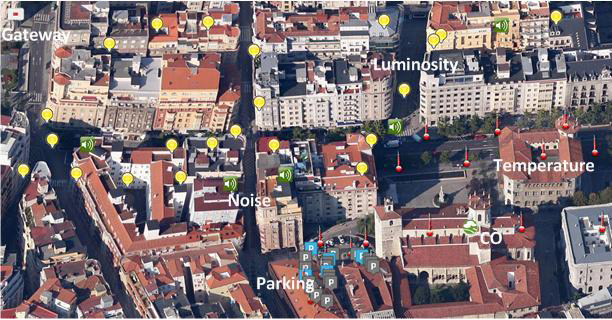
Santander Spain Smart City
I’m sure you will agree that this is seriously cool. Exciting times ahead with future cities on the horizon. This isn’t a simple and quick fix for cities and towns to implement, although this is going to happen in the near future. The reason why this is the direction we are heading in comes down to resource planning, reducing costs and waste while improving efficiencies. Some of the statistics that Tom mentioned through his talk included how sensors placed in bins reduced the fuel bills for the council by 25% by simply only emptying the bins that needed emptying along with how the parking sensors and signs saved approximately 8 minutes for how long it took people to find a car parking space in the city.
Smart cities of the future will be context aware systems that optimise the build environment for its inhabitants. No longer will people have to go elsewhere to find out information about where they already are. This is interesting as we should start to be prepared for a post screen environment which allows people to interact with the city without being tied to a specific device with a screen.
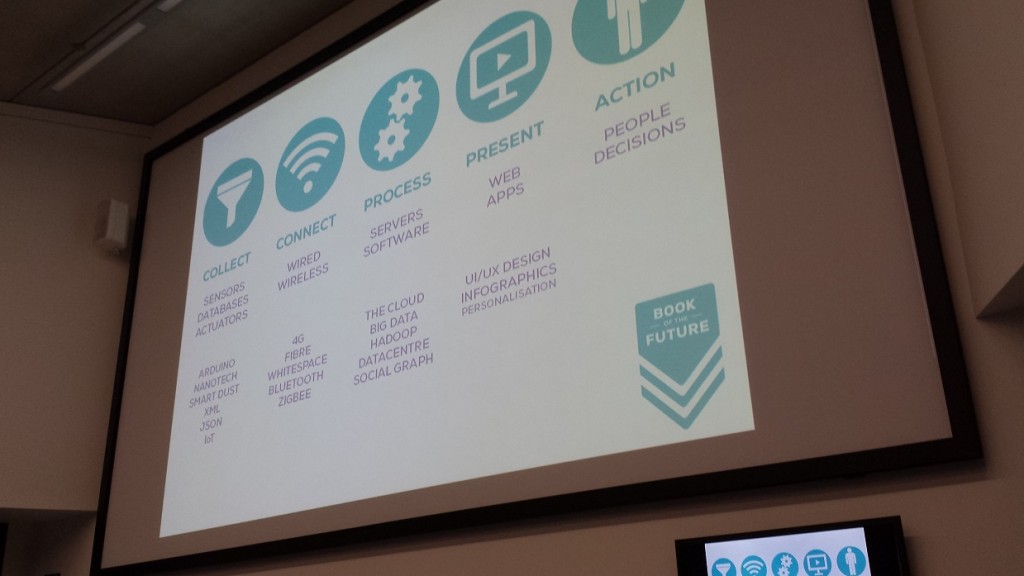
Smart Cities Data and Processes
Whenever anyone talks about smart cities and home automation, we always have to mention Nest, Google’s recent acquisition. This is really important though as Nest claim that their US customers save on average 20% on their energy bills. This isn’t just about cool tech, well ok, it is partially, but it is also about how this new technology can have a significant improvement on current technologies to save money for people and businesses.
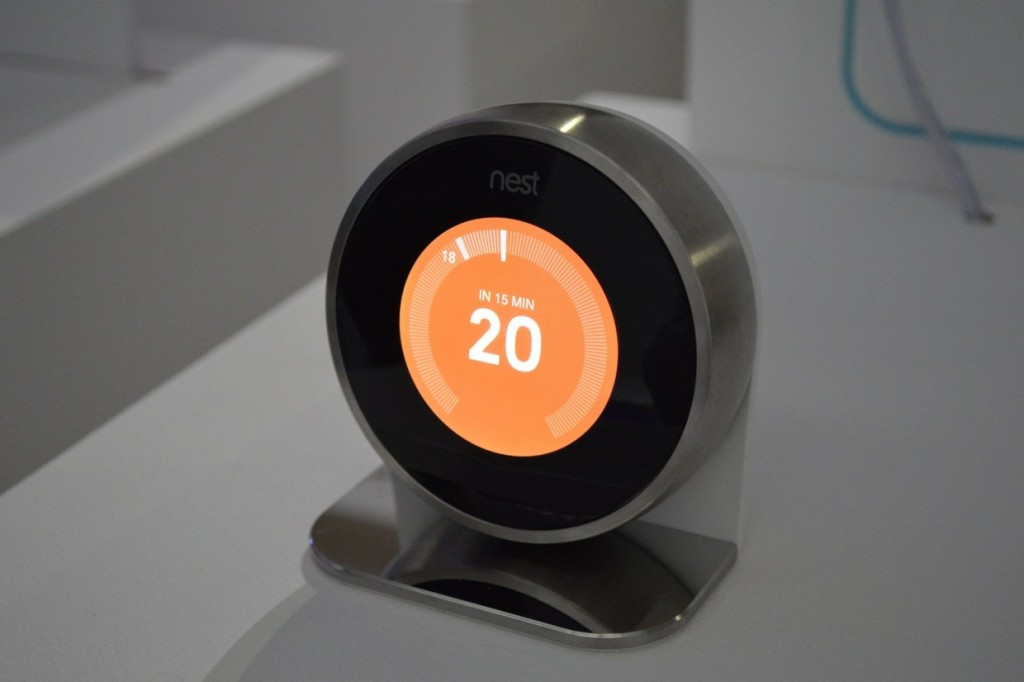
Nest Thermostat
The smart cities go beyond a reactive system. Imagine local councils knowing the actual noise and traffic levels produced from a factory near to a housing estate. Understanding this system allows the council to start to plan the towns and cities intelligently by using this environment and social feedback from the smart city technologies.
Tom went on to talk about the idea of connected councils where public services are reoriented around the citizen by connecting disparate data system to present a consistent and context aware experience for users. This is what Tom labels as “citizen centric design” which is all about the user opposed to a service centric design.
The main driving force for councils is to increase efficiencies, increase capabilities, increase satisfaction and increase engagement from the citizens. Smart cities work towards all of these goals. One example given, albeit a rather 1984 approach, was for adult care services. For example, if there are two call outs for environmental services at a property, there is a likelihood that adult care services should visit to see if there is any help needed.
Currently these conversations will be happening already in the council although more of a manual process whereby person A will walk over to person B in another department and mention it over making a coffee in the morning. The ability with smarter systems means that people don’t have to be used for the process, the system is used for the process. Meaning that people can be used for productive and value added work such as actually talking to the end users in this example.
Citizen centric design is designed to integrate data platforms and publish public APIs, allow for smarter strategic procurement which looks at the system as a whole, not just a specific job or department which will always lead to disparate systems being created. Using a hybrid agile development process for digital engagement skills and processes. Most importantly user testing, not simply pushing new technologies onto citizens
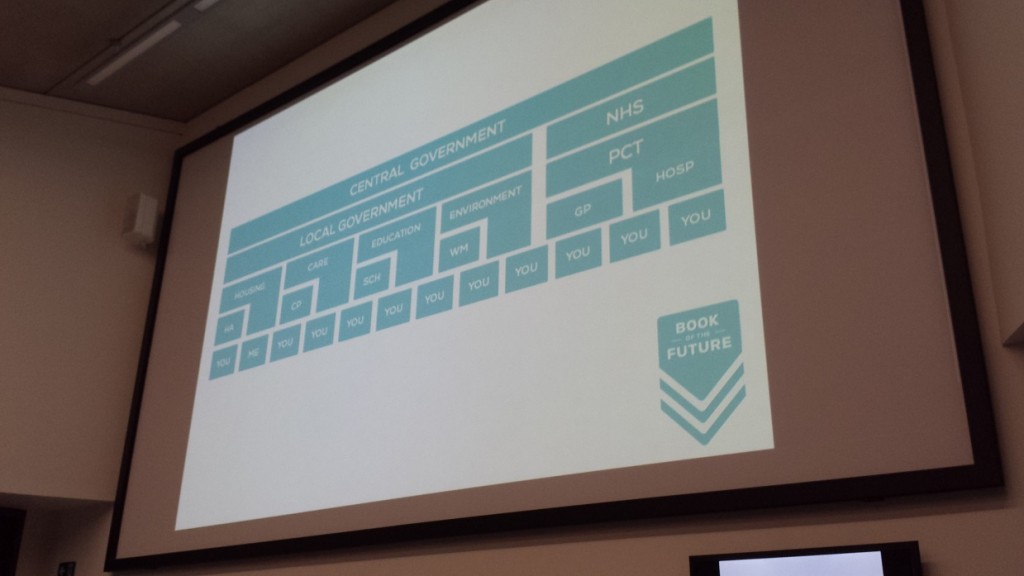
Current service centric design approach
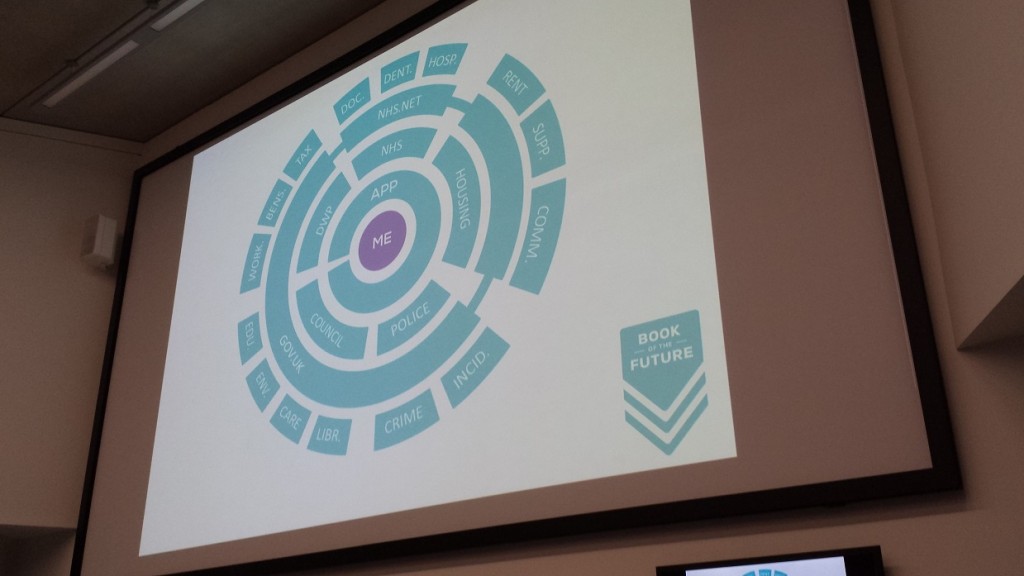
Citizen centric design
Dan Hill

Dan Hill
Next up we heard from Dan Hill, the Executive Director of Futures and Best Practice at the Technology Strategy Boards Future Cities Catapult. Dan started his talk by stating that we need to understand that a city isn’t a static environment where changes can be made periodically, instead the city is a real time system that we need to tap into.
Dan gave the example of Masdar smart city in Dubai which is best explained through this concept video from a few years ago;
Really interesting how leading cities are grasping the idea of smart cities and capitalising on this opportunity. While this is still under development, this is certainly an interesting way smart cities are taking shape.
One interesting point that Dan expanded on was that we don’t make cities in order to build infrastructure. Often cities are designed with an infrastructure led approach. Instead, he argued, that we build cities for culture, commerce, community, conviviality and the city itself.
When designing on an infrastructure led approach, the design lifetime of an infrastructure is often planned out to be 100 years such as for a metro system, which in reality is often much less when change of government comes into play. With digital you are lucky if a website stands the test of time of 100 weeks before it is out of date. This means that digital systems have to be able to adapt at a much faster rate than ever before.
Dan went on to talk about the value and cost of inefficient systems that smart cities could improve upon. Quoting Cedric Price with “Technology is the answer, but what is the question?” The question was raised that if we have made it clear to citizens the value of a smart city to them. I would argue that we haven’t which is why privacy concerns are often at the forefront of people’s minds.
An interesting The Museum of the Future in the UAE showcases how cities will look in the future;
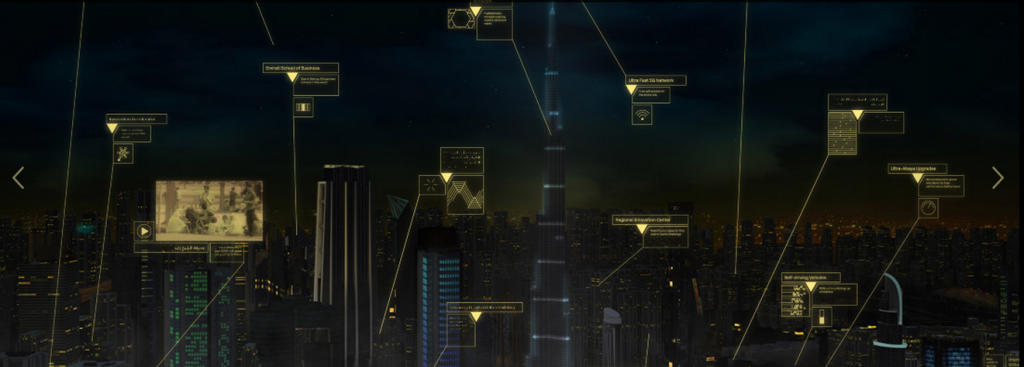
Museum of the Future
Really interesting concept looking at future cities and future technologies and how this will significantly change the world we live in and aid citizens with their daily life.
An interesting term was around “Urban Prototyping” which is all around creating products and services for the 21st century city and urban space. Looking at what citizens need within a modern city and looking at creating products and services specifically for these people.
Another project talked about was Sensing London which follows a similar theme around creating a smarter data driven city. The project is designed with three points in mind;
- Collecting data for insight
- Mashing data for innovation
- Trailing innovations in real city environments
With something much closer to home, it will be interesting to watch how this project progresses over the next few years. Another piece of technology mentioned was DisplayAnts which is designed to create interactive public displays with public information available.
Dan then went on to talk about how software and hardware is blending with the use of smart software to unlock vacant resources in the city. With one recent example being the Uber taxi app that has been spreading around the world. Interestingly too is that this new technology isn’t always welcomed with open arms with Uber getting a lot of criticism in both London and Spain from angry taxi drivers, bringing the locations to a standstill. If you aren’t familiar with Uber, it is the taxi booking app that connects you as a customer with a taxi with the click of a button and is really disrupting the traditional idea of booking a taxi. This type of disruptive technology is going to continue to increase over the coming years in a range of industries.
Another interesting piece of information was about research from MIT which stated that we could have 80% fewer vehicles on our roads if we were using smart cars. This is an enormous saving and one that I’m sure any commuter would appreciate. Then going beyond smart cities, Bridj was mentioned which is not just looking at real time data, but predictive data based on historic information and demands. Essentially allowing more resources to be deployed in an area that is likely to need more resources soon.
Beyond this, we have the likes of KickStarter for more product based ideas. Well we also have BrickStarter which takes the same concept but looks at projects for cities and the urban environment. Interesting idea for allowing citizens to essentially pitch ideas in their local communities.
All this being said, we still have a long way to come, with planning notices still being tied to lampposts. This is still seen as the best way to engage with the public about work that is happening in an area. Quite frankly, this is a joke. 99% of people simply walk past this and take no notice at all. This is not a good way to be engaging with citizens within a local area.
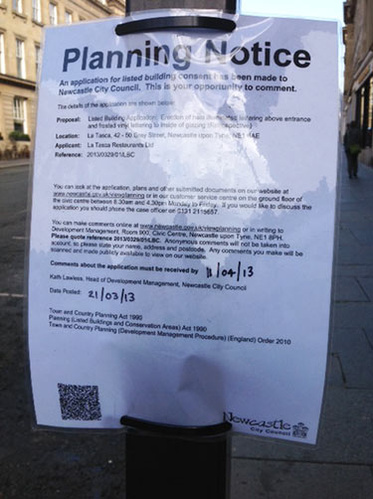
Planning Notice on Lamppost
Final Thoughts
The smart city is coming. This also requires a new approach within governments and local councils to fully understand how this change is going to impact the world we live in. Education is also going to be key to ensure the citizens fully understand what the smart city is, why it is so valuable and most importantly teaching people about a new way of interacting with official bodies.
One final thought to leave you with, imagine in the near future with a publically accessible CityAPI, maybe powered by things such as Fi-Ware. Whereby you can easily plug your business into this system to send and receive data that is essential for you and your customers. We already have cool WiFi Marketing & Analytics technology available for businesses, so this is an even more exciting time ahead in a digitally enabled world.
